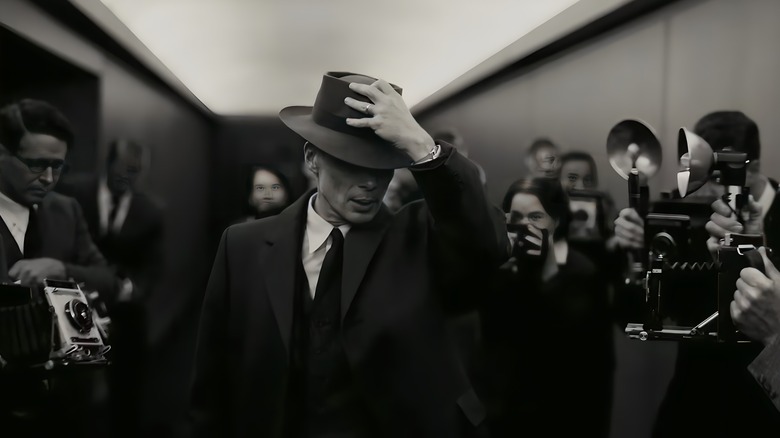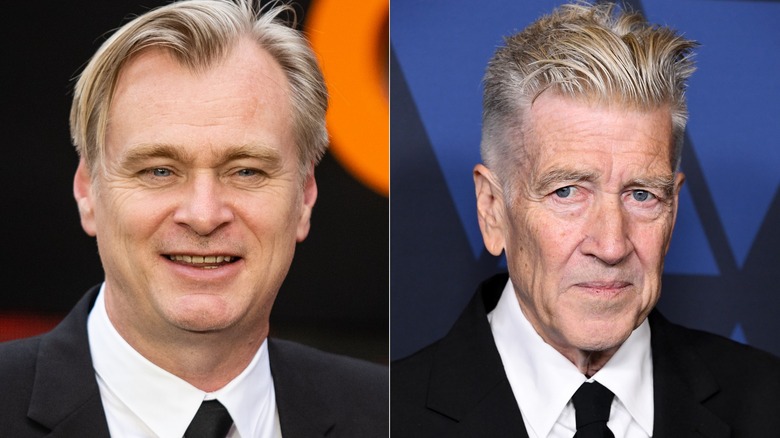Oppenheimer's Practical Explosion Fizzles Against David Lynch's CGI Trinity Test
Christopher Nolan loves practical effects so much that fans thought he would blow up a nuclear weapon for "Oppenheimer." Of course, Nolan didn't go to such extreme lengths in the name of cinema and authenticity, telling The Hollywood Reporter that he found it "a little bit scary" that his fans believed he'd go so far as to blow up an atomic bomb. But this is still Nolan, a creative who tells THR that the use of computer-generated imagery is "safe."
When it came to crafting the biopic's nuclear test sequences, which centers on the Trinity Test — the first-ever detonation of a nuclear weapon, Nolan made it clear: no CGI. "This can't be safe," the director said about his film's visual effects. "It can't be comfortable to look at it. It has to have bite. It's got to be beautiful and threatening in equal measure." And so, Nolan and his team pushed forward, using old-school film techniques and practical effects to film the Trinity Test sequence, which stands out as the film's showstopper. Over half the film leads up to the anxiety-inducing scene, showing just how threatening Oppenheimer's creation can be. The sequence has emerged as a fan favorite, with many calling it a major highlight that's worth the price of admission alone. "The dead silence in the theater during the trinity explosion," wrote Reddit user u/JustAShadeToTheLeft in a r/Movies thread discussing the film. "Something I'll never forget experiencing in a full theater."
Some, however, are a bit displeased by how Nolan's vendetta against CGI, led to an underwhelming sequence that doesn't show the true scale of the explosion. Some fans of David Lynch are even saying that the director did a better job showcasing the Trinity Test in "Twin Peaks: The Return."
Twin Peaks fans think David Lynch's Trinity Test is better than Christopher Nolan's
"[I]f anyone here has seen 'Twin Peaks' Season 3, I wager you can attest to the fact that same test sequence in that film ( done with CG I might add ) conveyed way more of the dread, awe and sheer terror of an atomic bomb blast," shared Reddit user u/Designer-Capital-263. For them, the Trinity Test in "Oppenheimer" fell flat, finding the build-up to the detonation far more exciting than the actual explosion. Others also agreed, saying that the Trinity Test in "Twin Peaks: The Return" was far more compelling because of how larger-than-life it felt. "[T]he trinity explosion should have been bigger and more scary and longer duration (lynch gave a great example in 'twin peaks the return' episode 8, it gave me a visceral feeling, dreamlike but terror and fear)," wrote user u/celebriancoffee.
In "Twin Peaks: The Return," director David Lynch takes a detour from the supernatural happenings of Twin Peaks to show viewers the power of the almighty nuclear bomb in Episode 8. It's a strange and overwhelming episode, even by Lynch's standards, but it's one that effortlessly displays the sheer scale and size of atomic weaponry. In the scene, Lynch shows the detonation of the Trinity Test from afar. Lynch then slowly glides the camera toward the explosion, highlighting just how large the detonation actually was. "Now this was actually scary," wrote YouTuber commenter @Animanji on the scene. "Unlike the 'Oppenheimer' sequence. Which is odd because everything leading up to that explosion was perfection."
In the context of "The Return," the detonation of a nuclear bomb signifies the beginning of a deep evil that takes over the town of Twin Peaks, something quite different than what Nolan was going for in "Oppenheimer."
Christopher Nolan and David Lynch reflect on the Trinity Test in different ways
In "Oppenheimer," the Trinity Test is the culmination of Oppenheimer and his Manhattan Project team's work. Audiences spend considerable time with the scientists working at the Los Alamos testing facility in New Mexico, seeing them ruminate on their invention. Oppenheimer himself is bound by patriotism and duty, debating the nature and ramifications of his weapon. In his biopic, Christopher Nolan is interested in showing off the technical aspects of the bomb, as well as the reactions it elicits from those who have created it.
His film isn't concerned with showing off the dread and suffering that manifests from a nuclear weapon until after the Trinity Test is completed. Authenticity is also on the director's mind, which is why there was an emphasis on practical effects. Nolan and his creative team conducted several experiments on camera to nail the explosion, creating something that truly feels man-made. In short, the sequence in "Oppenheimer" had to feel real. "I cannot explain how full of anxiety I was when I saw the countdown of the trinity test," Reddit user u/byponcho wrote. Several other fans agreed, particularly praising how the "Oppenheimer" sequence showed every character's POV and delayed the audio impact of the bomb.
David Lynch, however, isn't fascinated by the technical marvel of the Trinity Test sequence. For him, the atomic explosion is the start of a supernatural dread that takes over the town of Twin Peaks. The wide frame, single-take sequence of the Trinity Test in "Twin Peaks" highlights the raw power and chaos of the bomb, something that could be achieved through CGI. While both scenes are different and have their own unique purpose, it's clear that both are effective at reminding us just how terrifying nuclear weapons are.

